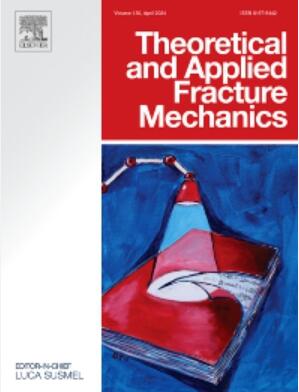Evaluation of dynamic fracture properties of ultra-high performance concrete: Experimental study and analytical modelling
IF 5
2区 工程技术
Q1 ENGINEERING, MECHANICAL
引用次数: 0
Abstract
Although existing studies have explored the fracture behavior of ultra-high performance concrete (UHPC) under dynamic loading, traditional fracture mechanics models fail to fully consider its heterogeneity as a multiphase composite material under dynamic conditions, resulting in size-dependent fracture parameters. Additionally, current studies do not provide a consistent interpretation of size effects under dynamic conditions. To address these issues, this study proposed an analytical method based on the boundary effect model (BEM) to predict the size-independent tensile strength (ft) and fracture toughness (KIC) of UHPC under different loading rates combined with three-point bending fracture tests. Using the peak load (Fmax) measured in tests, the model yielded closed-form solutions to eliminate size effects in fracture parameters, enabling a clearer understanding of the rate sensitivity of UHPC and providing a more scientific evaluation of its dynamic fracture properties. The effect of loading rate on fracture behaviors was comprehensively discussed. The results showed that the damage zone in UHPC expanded and the number of microcracks increased with increasing loading rate. As the loading rate increased from 0.02 mm/min to 200 mm/min, ft increased by 34.19 %, 32.97 %, and 29.88 % for fiber volume fractions of 1 %, 2 %, and 3 %, respectively. The incorporation of an appropriate number of steel fibers significantly improved crack resistance. ft of UHPC with 2 % fiber content increased by 44.46 % to 51.18 % compared to that with 1 % fiber content, but when the fiber content increased to 3 %, the enhancement effect was weakened. Moreover, with increasing fiber content, the sensitivity to loading rate decreased.
超高性能混凝土动态断裂性能评价:试验研究与分析模型
虽然已有研究探索了超高性能混凝土(UHPC)在动载作用下的断裂行为,但传统断裂力学模型未能充分考虑其作为多相复合材料在动态条件下的非均质性,导致断裂参数依赖于尺寸。此外,目前的研究并没有对动态条件下的尺寸效应提供一致的解释。针对这些问题,本研究提出了一种基于边界效应模型(BEM)的分析方法,结合三点弯曲断裂试验,预测不同加载速率下UHPC的尺寸无关拉伸强度(ft)和断裂韧性(KIC)。利用试验中测量的峰值荷载(Fmax),该模型得到了封闭形式的解,消除了裂缝参数中的尺寸效应,从而更清楚地了解了UHPC的速率敏感性,并对其动态破裂特性进行了更科学的评估。全面讨论了加载速率对断裂行为的影响。结果表明:随着加载速率的增加,UHPC的损伤区域扩大,微裂纹数量增加;当纤维体积分数为1%、2%和3%时,当加载速率从0.02 mm/min增加到200 mm/min时,ft分别增加了34.19%、32.97%和29.88%。适当数量的钢纤维的掺入显著提高了抗裂性能。与纤维含量为1%的UHPC相比,纤维含量为2%的UHPC的增强效果提高了44.46% ~ 51.18%,但当纤维含量增加到3%时,增强效果减弱。此外,随着纤维含量的增加,对加载速率的敏感性降低。
本文章由计算机程序翻译,如有差异,请以英文原文为准。
求助全文
约1分钟内获得全文
求助全文
来源期刊

Theoretical and Applied Fracture Mechanics
工程技术-工程:机械
CiteScore
8.40
自引率
18.90%
发文量
435
审稿时长
37 days
期刊介绍:
Theoretical and Applied Fracture Mechanics'' aims & scopes have been re-designed to cover both the theoretical, applied, and numerical aspects associated with those cracking related phenomena taking place, at a micro-, meso-, and macroscopic level, in materials/components/structures of any kind.
The journal aims to cover the cracking/mechanical behaviour of materials/components/structures in those situations involving both time-independent and time-dependent system of external forces/moments (such as, for instance, quasi-static, impulsive, impact, blasting, creep, contact, and fatigue loading). Since, under the above circumstances, the mechanical behaviour of cracked materials/components/structures is also affected by the environmental conditions, the journal would consider also those theoretical/experimental research works investigating the effect of external variables such as, for instance, the effect of corrosive environments as well as of high/low-temperature.
 求助内容:
求助内容: 应助结果提醒方式:
应助结果提醒方式:


